Of the two thousand or so ZZT worlds out there, you'll find a huge amount of variety in setting. There are alien worlds, medieval castles, underground towns populated by insects, fast food restaurants, monster filled caves, and on and on and on.
But for all the variety, one thing you'll find in countless games throughout ZZT's history are houses. Houses for the protagonist, their families, their friends, their mayor, their priest, and well, again it keeps going on.
The very earliest idea for Worlds of ZZT was a hand curated Tumblr blog posting nothing but screenshots of ZZT houses. You'll find a wide variety of designs, and can see the emergence of unofficial rules for what a ZZT home needs. I thought today we'd take a look at some of these houses and observe what makes them stand out. We'll go through this list chronologically, observing the evolution of the house.
1991
The House of Blues as seen in Town of ZZT
Of course, we need to start off by looking at the first house depicted in ZZT, Town's House of Blues. Like its source world, it is very abstract, and is really a house in name only. It is occupied by a jazz/blues musician who sings about the difficulties of being an object in ZZT. The board is large and empty, with some music notes used to recite the music back in order to proceed forward, making the first house a puzzle to be solved.
Bog's Cabin as seen in Smiley Guy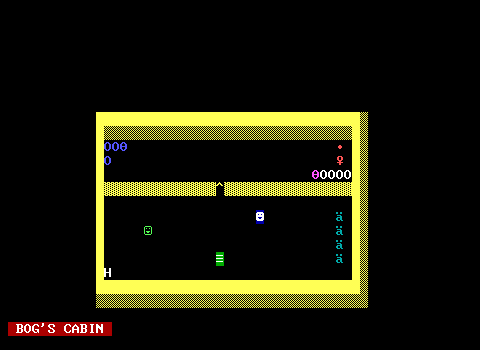
Bog's Cabin is another early depiction of a home. It is hardly any better of a place to live than the House of Blues. It's suffering from an infestation of centipedes which isn't doing Bog any favors.
Town Entrance as seen in The Stolen Gems
Here we get our first divergence from the idea of a house being nothing more than another board to serve gameplay. The Stolen Gems starts the player off in their home, and labels it as such. This early ZZT bed is made from bright solid walls for sheets and @ symbols for pillows. It's a house, but in the bare minimum idea of permanent shelter.
A neighbor's house is also depicted as well, this also includes some extremely primitive furniture in the corner, perhaps a desk and chair? It's open to the imagination as it's comprised of a solid wall and a boulder rather than an object to state what it is.
1992
Day as seen in Ezanya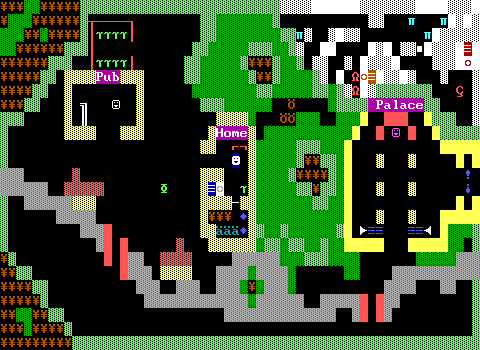
Moving to 1992, we get an early outlier. The player starts off in their home once again, but this time there's more purpose to it, with an additional room containing supplies to start the player off. Plus, a locked door hides a passage to advance the time of day to night. In a later game, there would likely have been a bed with a secret passage as part of it, only made accessible once it was time for the player to sleep.
The red objects at top form a side view of a bed, a depiction that is very non-traditional. We also get our first decoration with a houseplant in the corner.
Donstuheim's Room as seen in House of Amadus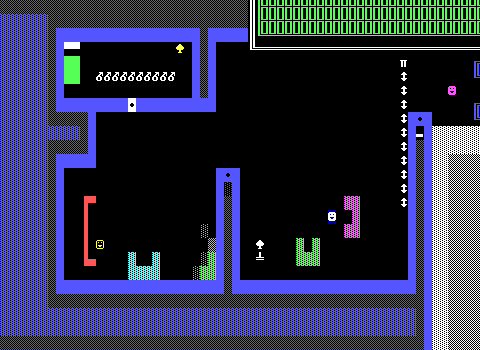
Now we're getting somewhere! This is the most massive house yet, taking up several boards to hold all of its rooms. The living room has several new kinds of furniture. There are chairs and couches, built with objects in some instances, to help with the scale. The multi-tile lamp in white on the right side is an uncommon piece of furniture as well!
The bed is notable as well. It takes on the general design that would go on to become the most common by far, but does so in a world without STK colors. Using half characters for pillows sizes better, but leaves a gap as there can't yet be any background character. Personally, I'd have gone with the other half-block character and lived with the bed not being flush with the wall.
It's still an early ZZT game however, and so the bedroom also appears to have several bombs inside.
Kitchen as seen in House of Amadus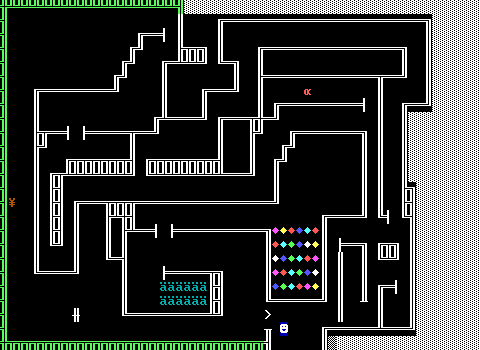
Of course, the game isn't going for a realistic depiction of a house, after all, this board here is the game's kitchen.
Your Room as seen in Crime Ring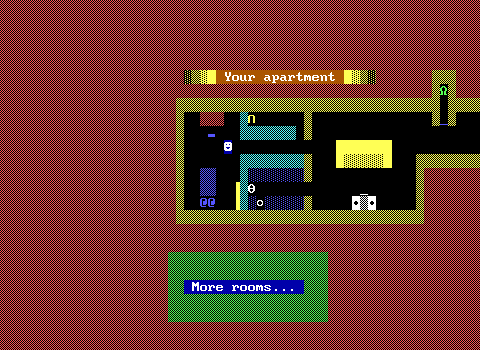
Crime Ring is a very complex game for the era, and features the player traveling around a city trying to solve a murder and uncover and end a crime ring. Again the game starts with the player in their home. Here, it is only an apartment rather than a house.
The furniture includes a bed using @ pillows again, half-block characters for a dresser and small chair at a desk. A theta represents a dual-basin kitchen sink, and an intersection sign makes a toilet. The intersection glyph falls out of favor, but shows up a bit more early on where City of ZZT's influence led to people cribbing its own toilet design.
Inside Room 48 as seen in Crime Ring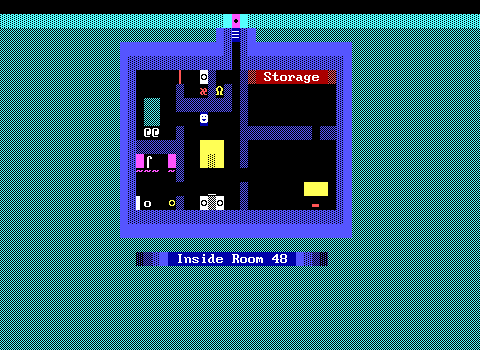
There are other apartments in Crime Ring as well. Room 48 uses more of the same, but with a bit of a more modern looking toilet. The showerhead and curtain are also quite impressive!
1993
Hut.Prof. Dave as seen in The Lost Monkeys
In 1993, Chris Jong released The Lost Monkeys, a wonderfully charming adventure about recovering some escaped monkeys. After sailing to the island, the protagonist enters the professor's hut to accept the quest to find them, and what a hut it is!
The bedroom uses more @ pillows, and features an oak desk and green drawer (don't open it unless you want an instant game over). A rather large television set is backed against the wall of the living room, with some chairs a comfortable distance away. A portrait of the professor hangs on the wall.
The bathroom also uses the shower curtain seen earlier, though this time opts to include the drain rather than the showerhead. The toilet is the largest item in the hut.
The kitchen has a table, chairs, fridge, and sink. It's the only place two people can sit across from each other in the whole joint.
Lastly, more detail is added to the building itself. Cyan walls are used to represent glass windows, and the rooms are no longer entirely open, each has a door that swings open and closed to give some privacy. The hut doesn't take up an entire board and Jong uses a green pattern for the background to represent the grassy surroundings of the hut. All in all, it's a nice step forward!
Oak Apartments as seen in Oak Town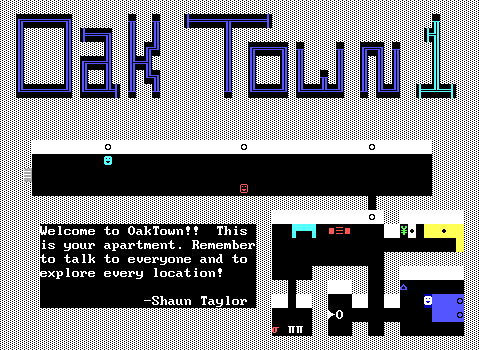
Shaun Taylor's Oak Apartments aren't so intricate, but still brings in some new designs. Firstly, the bed uses a new character for the pillows, simulating them being on top of the bedspread despite not having background colors available. Clever! In the kitchen the fridge and sink share the same character, only using color to differentiate the two.
The living room has no tv, but instead a large stereo system the player can interact with to hear two short lines of music. In the bathroom there's a toilet that can't be interacted with at all, which is surprising given the amount of scatological content is in the rest of the game.
The lower left room is a new one: the laundry room. The washer and dryer are both represented by pi characters, which I think work pretty well for them. However, the biggest new idea, is the red lowercase sigma, which is the player's pet dog! The dog, obviously, urinates on the player's leg when touched.
Meesh's House as seen in Keesh's Quest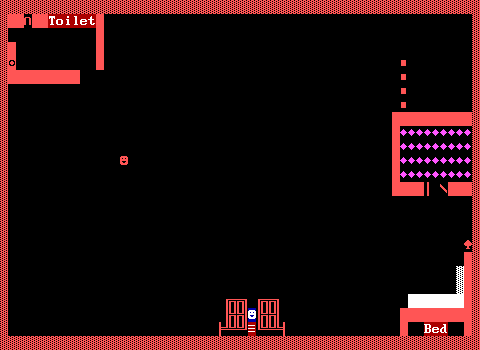
Just because the average quality steadily increases over time, doesn't mean there's no regression. Everybody's got to start at the bottom and here in late 1993 you can still find that big empty void for a house. The bathroom is there, with its intersection toilet and round sink, but the rest of the house is nothing more than a giant bed viewed from the side, and labeled as such in order to make sure the player knows what they're looking at. The giant size of it does allow for the inclusion of a bedpost however.
1994
Your House, Floor 1 as seen in Code Red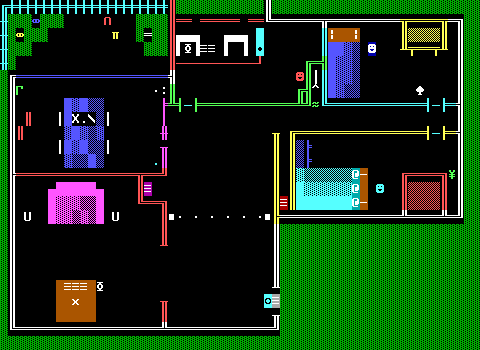
Alexis Janson's Code Red was a huge influence to adventure game design in ZZT, become the definitive example of the "wake up and save the world" style story which became a sort of standard for adventure games in ZZT for years to come.
The scaling is massive compared to the people who live there, but is at least somewhat consistent with itself! The beds have headboards. The dressers have visible drawers. The computer room has a monitor, keyboard, disk drive, and printer, which all can be interacted with. (Never take a disk out when it is spinning.)
Janson even recognizes the inherent ambiguities of ASCII characters with the closet. What's inside is a vacuum, a frontal view with a vertical portion coming out of a small pyramid shaped base, but opening the closet jokes about how it's a "bony arm" trying to grab you before revealing what you're actually looking at. By 1994, ZZT games have become meta.
The house itself is rather varied in color, but it appears to be an attempt to have painted walls, there's just no easy way to do two colors without making the walls extra thick.
Your House, Floor 2 as seen in Code Red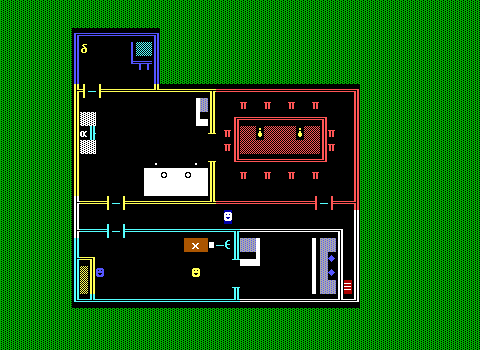
Of course, there's even more to this modern suburban family home. The second floor has a kitchen complete with walk-in fridge (and a walk-in pantry!), a large stovetop with adjustable burners, and sink. The dining room must be massive, with seating for a dozen. This is also the introduction of ZZT's infamous candle objects. (Despite appearing as upsidedown exclamation marks here, they cycle through various accented "i" characters immediately on entering.) These candles appear in so so many games, with the flickering flames simulated by adjusting accents.
The game room consists of a smaller tv set portrayed from above with an attached Super Nintendo. It connects to the home's only bathroom where a bathtub and sink are always full of water.
What really makes the home from Code Red stand out so much isn't that it has so much furniture inside, but that so much of it can be interacted with. You can sleep in the bed, get dressed from the dresser, spill trash cans, watch TV, print an article on the computer, vacuum the house, unplug the SNES, cook some fish, flood the bathroom sink, and lord knows what else I'm missing. This level of interactivity is unparalleled, and the player's actions on the first few boards dictate which of several scenarios the player gets to experience.
1995
Fred's Room as seen in Fred! Episode 1: Space Fred!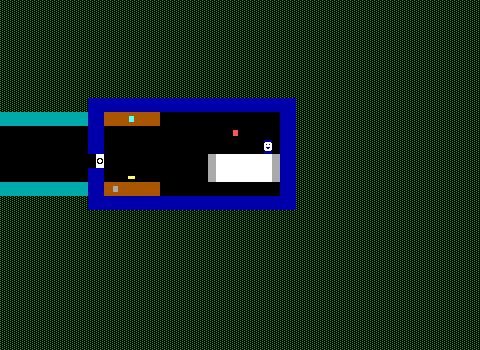
The elaborate home from Code Red is definitely the exception. Myth returns us to a more modest abode in the first of the Fred games. The home itself is several boards long, but Fred's room is how the game begins, with the alarm clock going off until Fred decides to smash it to bits. Fred can also dress at their dresser, but is permitted to play the game in his PJs as well. At the top of the room is Fred's computer, a 33MHz 486DX. Halfway through 1995 I think that computer would be showing its age, but as Fred notes, it runs MegaZeux.
!c;LOCKED FILE (Rook's Home) as seen in Sivion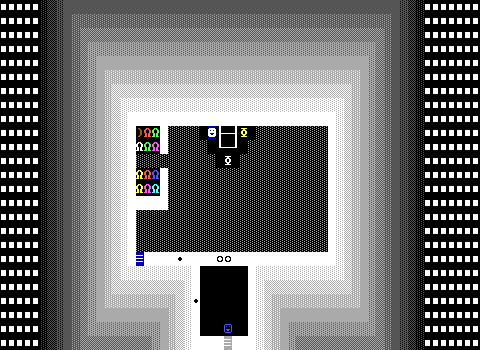
When designing homes in a game, ZZT or otherwise, corners usually get cut. There's rarely need for them to be filled with every necessity for living, with Mothingos sticking only to what's relevant for his game. There's a bed, with a sort of wireframe look being composed out of objects, a massive closet filled with clothes, and a large mechanical door and an entire second board dedicated to depicting the gears which operate it.
I don't know either.


